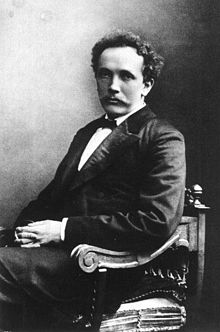- Die schweigsame Frau
-
Richard Strauss  Operas
Operas- Guntram (1894)
- Feuersnot (1901)
- Salome (1905)
- Elektra (1909)
- Der Rosenkavalier (1911)
- Ariadne auf Naxos (1912/16)
- Die Frau ohne Schatten (1918)
- Intermezzo (1924)
- Die ägyptische Helena (1927)
- Arabella (1932)
- Die schweigsame Frau (1934)
- Friedenstag (1938)
- Daphne (1938)
- Die Liebe der Danae (1940)
- Capriccio (1942)
Die schweigsame Frau (The Silent Woman) is an opera in three acts by Richard Strauss with libretto by Stefan Zweig after Ben Jonson's Epicoene, or the Silent Woman.
Contents
Performance history
It was first performed at the Dresden Semperoper on 24 June 1935, conducted by Karl Böhm.
A work of great charm when well cast and performed, it has nevertheless proved one of Strauss' less successful operas. Strauss' association with a Jewish librettist in 1935 Germany provoked a hostile response from Hitler and Goebbels, and even after the war, it has enjoyed relatively few revivals.
The work had its United States premiere at the New York City Opera on October 7, 1958. It was performed at the Santa Fe Opera in 1987 and 1991, and also at Garsington Opera in 2003.
Roles
Role Voice type Premiere, June 24, 1935
(Conductor: Karl Böhm)Sir Morosus, a retired admiral bass Friedrich Plaschke Widow Zimmerlein, his housekeeper contralto Helene Jung Schneidebart, a barber high baritone Mathieu Ahlersmeyer Henry Morosus, nephew of the admiral high tenor Martin Kremer Aminta, his wife coloratura soprano Maria Cebotari Isotta, opera singer coloratura soprano Erna Sack Carlotta, opera singer mezzo-soprano Maria Hundt[citation needed] Morbio, opera singer baritone Rudolf Schmalnauer Vanuzzi, opera singer deep bass Kurt Böhme Farfallo, opera singer deep bass Ludwig Ermold The parrot spoken Other actors, neighbors Synopsis
A rich, retired admiral, Sir Morosus, cannot bear noise of any kind, particularly his garrulous housekeeper, so his barber suggests she should be replaced by a quiet young wife. Morosus argues that a silent woman cannot exist and that he is too old to marry. His long-lost nephew Henry appears in pursuit of an inheritance and Morosus believes he has found alternative companionship. However, Henry is married to Aminta, a member of an operatic troupe, and his uncle has no time for such noisy activity. He dismisses the troupe, disinherits Henry and demands the Barber finds a silent woman for the next day. The Barber and Henry hatch a plan and present Morosus with three possible brides (the opera troupe in disguise). Morosus rejects the clumsy peasant (Carlotta) and the bluestocking (Isotta) but falls in love with the quietest called Timidia (Aminta). But as soon as the marriage is sealed her raucous true nature emerges - and she wants to buy a pet parrot. Henry promises to arrange an annulment of the marriage, but Timidia will not accept any bribes as she wants to remain Lady Morosus. Morosus's divorce petition fails but at his point of total despair the deception is revealed. His initial fury turns to laughter and the troupe salute him. Aminta offers daughterly love and Morosus is content to accept Henry as his heir: "A rare delight it is to find a silent, beautiful girl, but it is more delightful when she belongs to another man".
Recordings
Year Cast
(Henry Morosos,
Sir Morosus,
Housekeeper,
Barber, Aminta)Conductor,
Opera House and OrchestraLabel[1] 1959 Fritz Wunderlich,
Hans Hotter,
Georgine von Milinkovic,
Hermann Prey,
Hilde GuedenKarl Böhm,
Vienna Philharmonic Orchestra and ChorusAudio CD: DG
Cat: DG 445 335-21971 Donald Grobe,
Kurt Böhme,
Martha Mödl,
Barry McDaniel,
Reri GristWolfgang Sawallisch,
Bayerische Staatsoper Orchestra and Chorus
(Audio recording of a performance in the Nationaltheater, Munich, 14 July)Audio CD: Orfeo,
Cat: C 516992 I1977 Eberhard Büchner,
Theo Adam,
Annelies Burmeister,
Wolfgang Schöne,
Jeanette ScovottiMarek Janowski,
Staatskapelle Dresden and Dresden State Opera ChorusAudio CD: Testament
Cat: CMS5660332References
- Notes
- Sources
- Amadeus Almanac, accessed 6 November 2008
- Warrack, John and West, Ewan (1992), The Oxford Dictionary of Opera, 782 pages, ISBN 0-19-869164-5
Categories:- Operas by Richard Strauss
- German-language operas
- Operas
- 1935 operas
- Stefan Zweig Collection
- Operas based on plays
- Operas set in England
Wikimedia Foundation. 2010.
